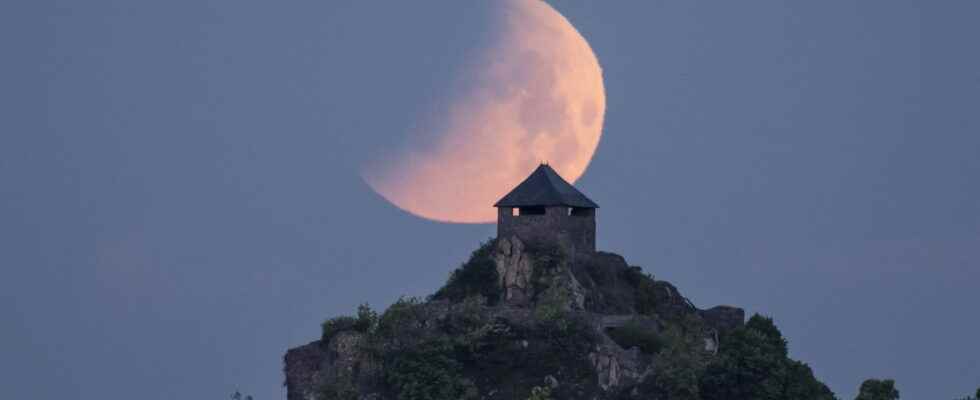MOON ECLIPSE. This Monday, May 16, 2022, a total lunar eclipse coupled with a blood moon was visible from Europe, including France, the American continent and Africa. The most beautiful pictures.
[Mis à jour le 16 mai 2022 à 18h08] The lunar eclipse that occurred on the night of Monday May 16, 2022 was the only total lunar eclipse of the year visible in Europe. Also observable from the east of North America, from South America and from Africa, the passionate photographers had a great time immortalizing the astronomical phenomenon in its entirety, which lasted 1 hour 24 minutes. His observation in France was only partly visible during its total phase, from 5:29 a.m. to 6:09 a.m., when daylight broke in Paris.
During this eclipse, the Moon was red (full blood moon phenomenon). This color is a consequence of the absence of sunlight. Red rays filtered by the Earth’s atmosphere are returned to the Moon, as during sunsets and sunrises that we admire. Discover the May 16 lunar eclipse photos :
This Monday, May 16, 2022, the Moon entered the penumbra of the Earth at 3h32 (for Paris time) and the eclipse began to be visible in its entirety at 5:29. The peak occurred at 6:11 a.m.. At this time, the lunar disc, immersed in the shadow of the Earth, has taken on a luminous color ranging from pinkish to purple-red, a phenomenon called a “blood moon”. HAS 8:50 amthe Moon has emerged from the penumbra.
This phenomenon only occurs during total eclipses. As the Moon advances into the shadow of the Earth, the Moon takes on a red hue, which is called a blood moon phenomenon. “The longer wavelength rays (red) continue to reach the Moon and give it a coppery hue. It is this same phenomenon that gives sunsets their color”, explains France 3 Region. The red color of the Moon varies with atmospheric conditions, ranging from orange to bright red.
The next total lunar eclipse will occur on November 8, 2022, but it will only be visible from Asia, Oceania, and the Americas. Console yourself in France this summer with the great meeting of the Perseid stars and their shower of shooting stars during the now famous night of stars.
The next fully visible lunar eclipse in mainland France will not take place before December 20, 2029… But scientists predict an incredible spectacle all night long!
If the sky is clear, there is no problem observing a lunar eclipse with the naked eye, without any danger (unlike a solar eclipse) and without special equipment. We advise you to position yourself in the direction of the clear horizon and to turn towards the southwest. The place of observation must be located far from any light pollution (at the top of a hill, on a beach etc…) As for a supermoon, in case you are in an area where clouds veil its visibility, you can arm yourself with your telescopeof yours binoculars or a pair of astronomical glasses to better observe the lunar eclipse.
For those who wish to immortalize the phenomenon, you can also bring a standard 50 mm lens as well as longer focal length lenses (between 200 mm and 2,700 mm on a full frame sensor). The important thing is to be able to have a tripod to avoid camera shake. The use of a telephoto lens is obviously ideal so that the moon fits entirely into the frame, but for photographers with a short focal length, you can make an eclipse trail (successive superimpositions of the different phases of the eclipse on the same photograph). Given the low light during the lunar eclipse, set your camera to medium to high sensitivity depending on the phase of the eclipse, as well as a large aperture.
It is important to point out that the astronomical phenomenon of the lunar eclipse is only possible when the Moon is full. A lunar eclipse can only occur when the Moon is atopposite of the Sun with respect to the Earth and that it is therefore in the full moon phase.
A partial lunar eclipse is a phenomenon that occurs when the Earth moves between the Moon and the Sun without these three stars being completely aligned.
